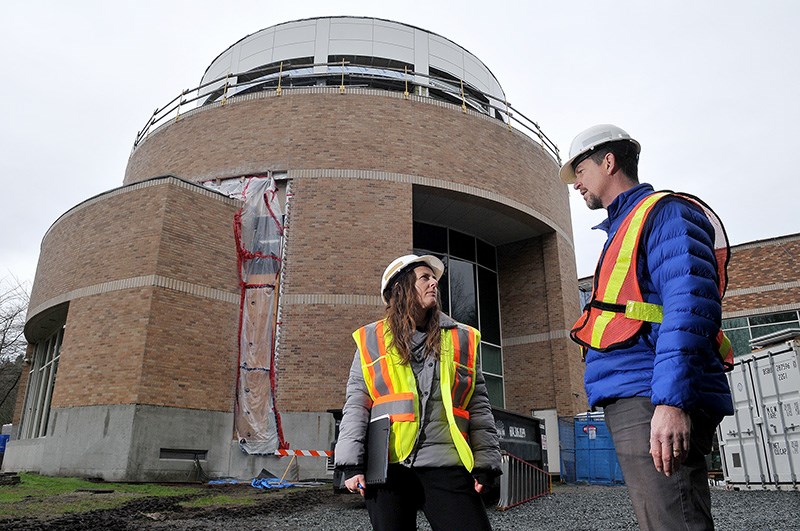The end of blue tarps and scaffolding at the Port Moody civic and recreation complexes is in sight.
But the full cost of the extensive repair and renovation project is still being tabulated, said the city’s general manager of cultural services, Kate Zanon.
That’s because, like many big renovation projects, there were complications and new discoveries as the work progressed.
Dave Stevens, PoMo's manager of facilities, said much of the work at the rec complex is to repair and replace building components, like the roof and facings in parts of the building that were constructed in the 1970s, that had reached the end of their lifespan while components in the newer parts of the building, like the gym and second arena that were added in 2006-’08, are being updated to improve energy efficiency.
The civic building work has, however, proved much more complex.
Built between 1994 and ’96 and designed to evoke an old railway roundhouse, the structure that includes city hall, the Inlet Theatre and the library essentially became a leaky condo, sharing many of the problems that plagued condos built during the late 1980s and ’90s. Those included building code and design deficiencies that, when combined with poor quality workmanship, made buildings prone to water ingress behind exterior walls, resulting in premature corrosion problems, rot and even mould.
Stevens said city hall’s problems never reached that extent but there were leaks around windows, behind flashings and bricks, as well as corrosion in some of the building’s structural steel beams.
A building envelope assessment done for the city in 2015 by Elemental Engineering cited a variety of issues, including:
• poor design of parapets and the lack of overhangs that invited water into the building and caused staining of the walls, corroded flashing and soggy masonry;
• lack of a drainage cavity in unprotected stucco exterior walls that exposed gypsum material to excessive moisture;
• lack of a sheathing or protective membrane behind some of the building’s brick exterior walls that allowed moisture to penetrate, corroding steel studs and beams, as well as weakening masonry;
• a thin, single-ply roof membrane that was failing as it reached the end of its normal lifespan;
• and windows where grout was failing.
The report estimated at the time it would cost almost $4 million to repair city hall’s problems. But Stevens said once the project began in summer 2017, the true extent of the problems became more clear.
“The scope became very large because of all the interrelated components,” he said, adding once the exterior of the building was removed, it quickly became apparent windows would also need to be replaced.
“When you see something, you have to deal with it,” Zanon said, adding the city was able to heed a lot of lessons learned from the province’s leaky condo crisis.
Stevens said some components of the project are an upgrade that will improve the building’s energy efficiency as well as create a better environment for people who work there or visit. They include thicker windows and a new heating and air conditioning system. Others, like a new bitumen roof, will have a longer lifespan and require less maintenance, reducing costs to the city over the long term.
Most of the work, once the scaffolding and tarps are down, will be invisible to the general public.
The most apparent legacy of the repairs will be a slight change to the building’s brickwork, much of which had to be replaced because bricks were failing or they needed to be removed as work was done to other components.
Stevens said care was taken to colour match the original multi-coloured brickwork as much as possible but they were only able to achieve six of seven hues. He said over time, the new bricks will weather to more closely resemble the parts of the building’s exterior that didn’t have to be replaced.
Zanon admitted the project has presented challenges, especially keeping the building and all the departments that work there functioning and accessible as work progressed.
“We went into this knowing it would take some time,” she said, adding completion is anticipated sometime in the spring.
The bill will likely be presented to city council at the end of February.



